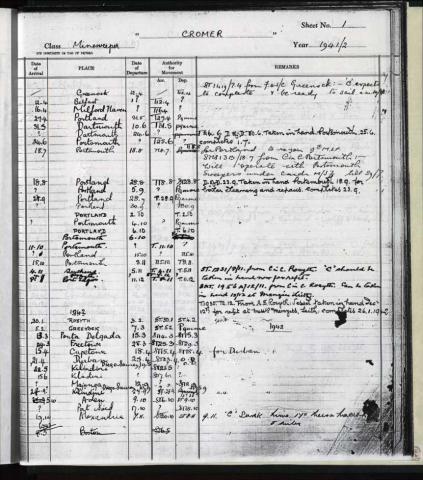Essential Information
| Location |
National Maritime Museum
|
|---|---|
27 Dec 2012
Anybody investigating the activities of the Royal Navy during World War II will be used to visiting the National Archives at Kew. However, July’s item of the month shows that a treasure trove of information can be found here at the Caird Library, particularly in the series of Admiralty Movement Books.
In order to get an overview of the movements of Royal Navy ships during World War II, a researcher might consult several different sources at the National Archives. ADM 187, for the years 1939-45, the so-called ‘Pink List’, was compiled every three to four days and shows the stations and movements of ships. Vessels of the Royal Navy as well of those of Allied countries are included, with dates of arrival and departure recorded. ADM 208 is a weekly ‘Red List’ that was used to list all minor vessels in home waters. The Red List is arranged by commands, once again including vessels of Allied countries.

In addition to the records at Kew, the Caird Library has many unpublished treasures on its shelves. In many cases these little-known resources can assist family and naval historians. Instead of visiting the National Archives and checking the documents mentioned above, the Admiralty Movement Books are an excellent source which can be used to obtain very similar information. Photographic copies of the official manuscript records cover movements of Royal Navy ships (as well as vessels of the Royal Australian, Canadian and Indian Navies) during World War II. They include many entries from vessels on government service through to trawlers (although landing craft, hired vessels and troopships are not included). The books are in two sequences arranged alphabetically by name of ship: one for surviving vessels, another for those sunk. While details vary, a ship’s entry usually includes sailings, convoy numbers, repairs, and significant incidents such as a torpedoed crew being rescued.
The Movement Books, more properly called Movements of HM ships and submarines: unsunk (in 26 volumes) and Movements of HM ships and submarines: sunk (in 9 volumes), were produced by the Admiralty in London during the war. These volumes have recently been catalogued to individual letter ranges making it far more convenient to request them via our Aeon ordering system. Once in the reading room, handle the volumes carefully: they measure 33 x 37 cm (37 x 14.5 inches) and weigh an awful lot!
Two examples taken from the volumes demonstrate what sort of information can be found:
Movements of HM ships and submarines: sunk
- Name: Cromer
- Type: Minesweeper
- Year: 1941/42
The volume records that the minesweeper Cromer was taken in hand in Portsmouth on 22 September 1941. It was docked later in Greenock where ‘“C”[Cromer] expects to [be] complete[d] and be ready to sail’ on 10 April. The date of departure was two days later on 12 April 1941. On 18 August 1941, Cromerleft ‘for Portland to re-join the 9th M.S.F. [minesweeping flotilla] operat[ing] with Portsmouth sweepers’. The minesweeper sailed intensively between Portsmouth and Portland, then in the next year was transferred to the east of the Mediterranean Sea taking a long journey via Porta Delgada (Azores), Freetown (Sierra Leone), Cape Town (South Africa), Durban (east coast of South Africa), Aden (Yemen), Port Said (Egypt) and Alexandria (Egypt). The Cromer’s entry was closed with a note recording where it was sunk on 9 September 1942. Other sources indicate that the Cromer hit a mine.
Movements of HM ships and submarines: unsunk
- Name: HMS Rochester
- Type: Escort Vessel
- Year: 1939
On 20 June 1939, the volume records ‘H.M.S. Rochester: ship will be ready for sea service [on] 3 July … Recommissioned with a Chatham crew for service on The China Station’. Two months later the vessel arrived at Malta where it was ‘taken in hand for defects to steering gear, feed pumps. Completed [on] 11 August’. On 12 September the Rochester was ‘approved to remain in East Indies’ then in November she embarked for the ‘Red Sea and then Bay of Biscay’.
Staff members at the Caird Library prepared some indexes of the lists of commissioned ships, both sunk and unsunk, and they are available to view in the reading room. Additionally, there is an index of commissioned ships which could help if the fate of the vessel is not known.
Gregory, Assistant Librarian